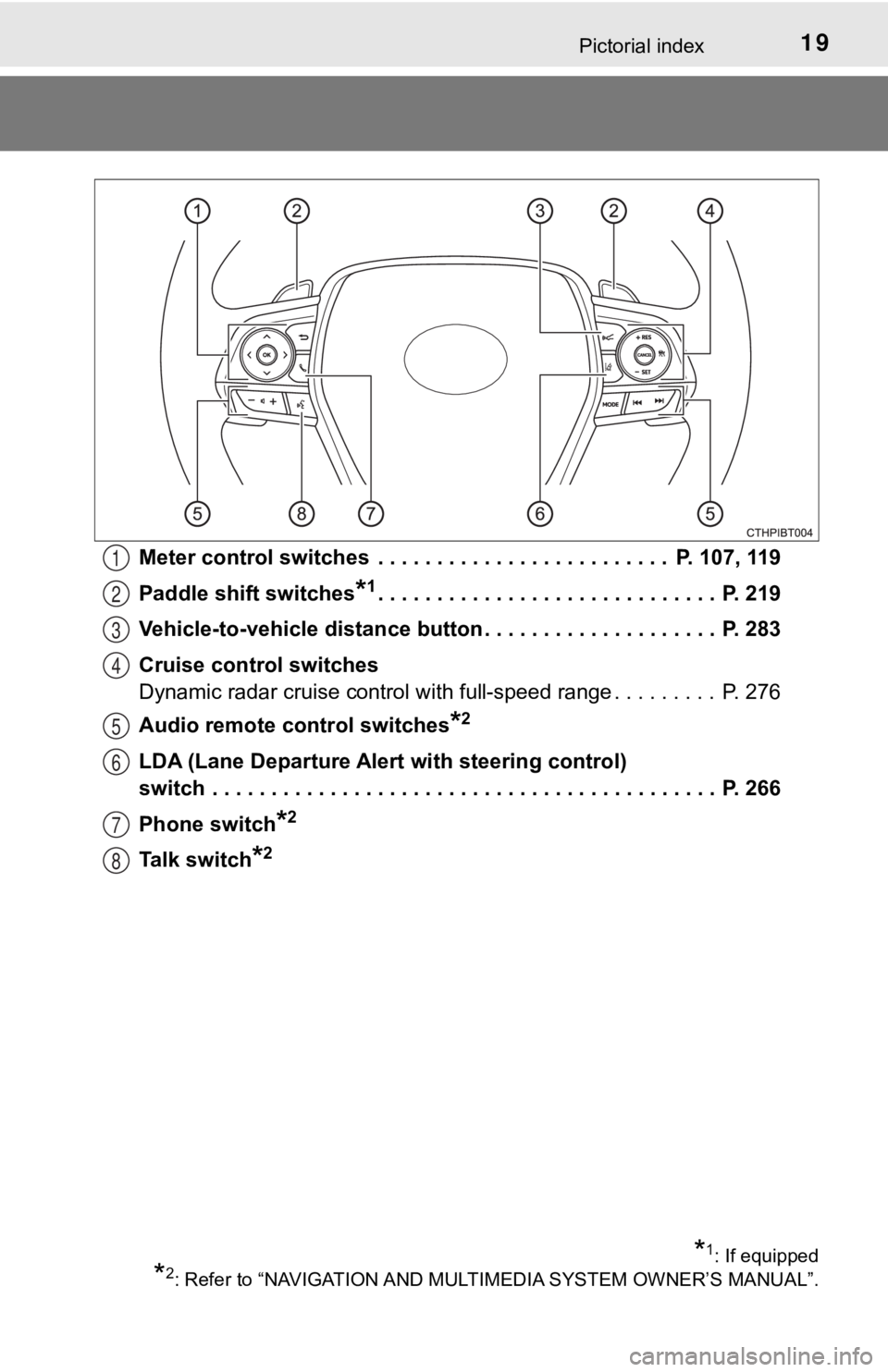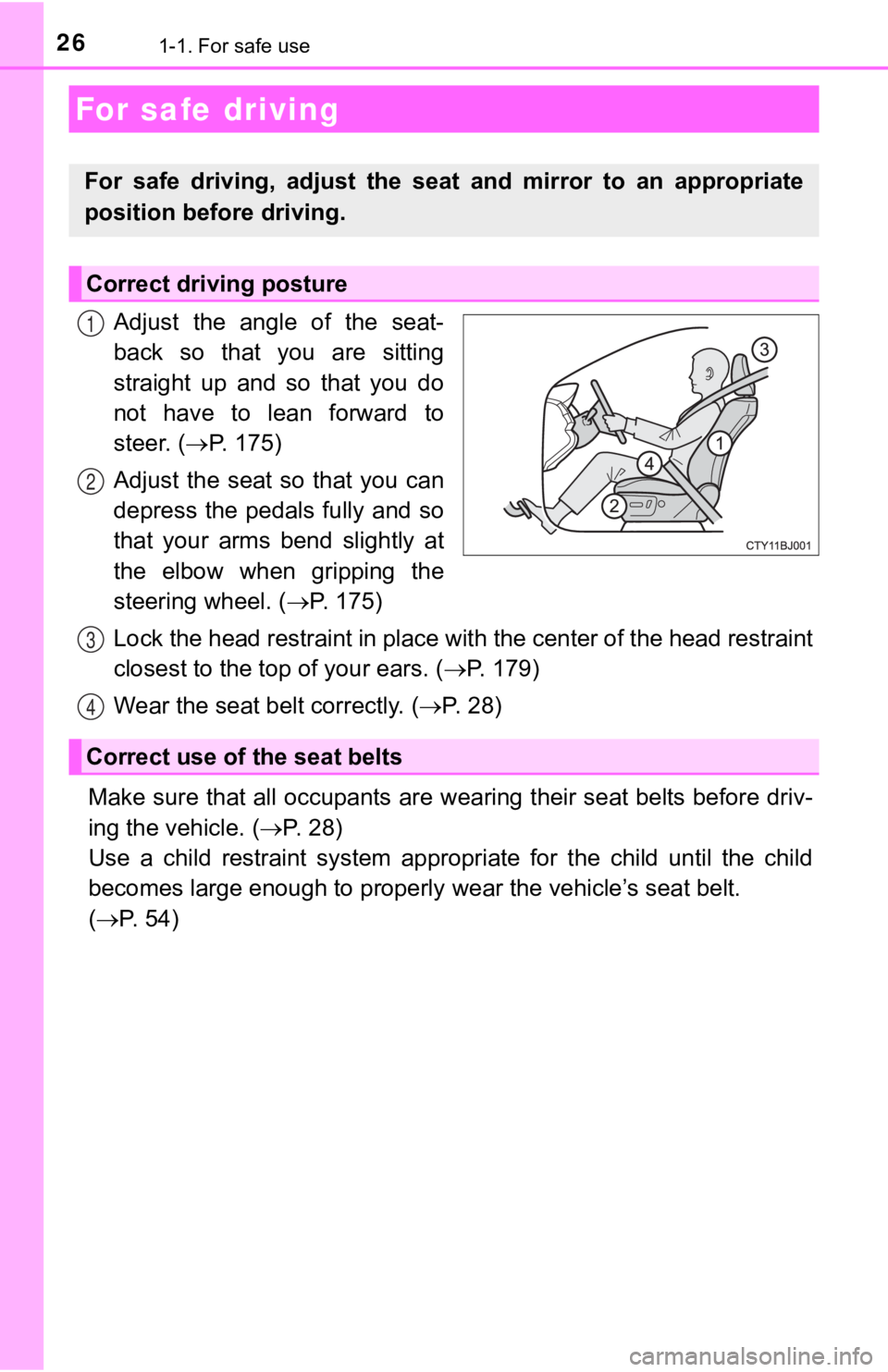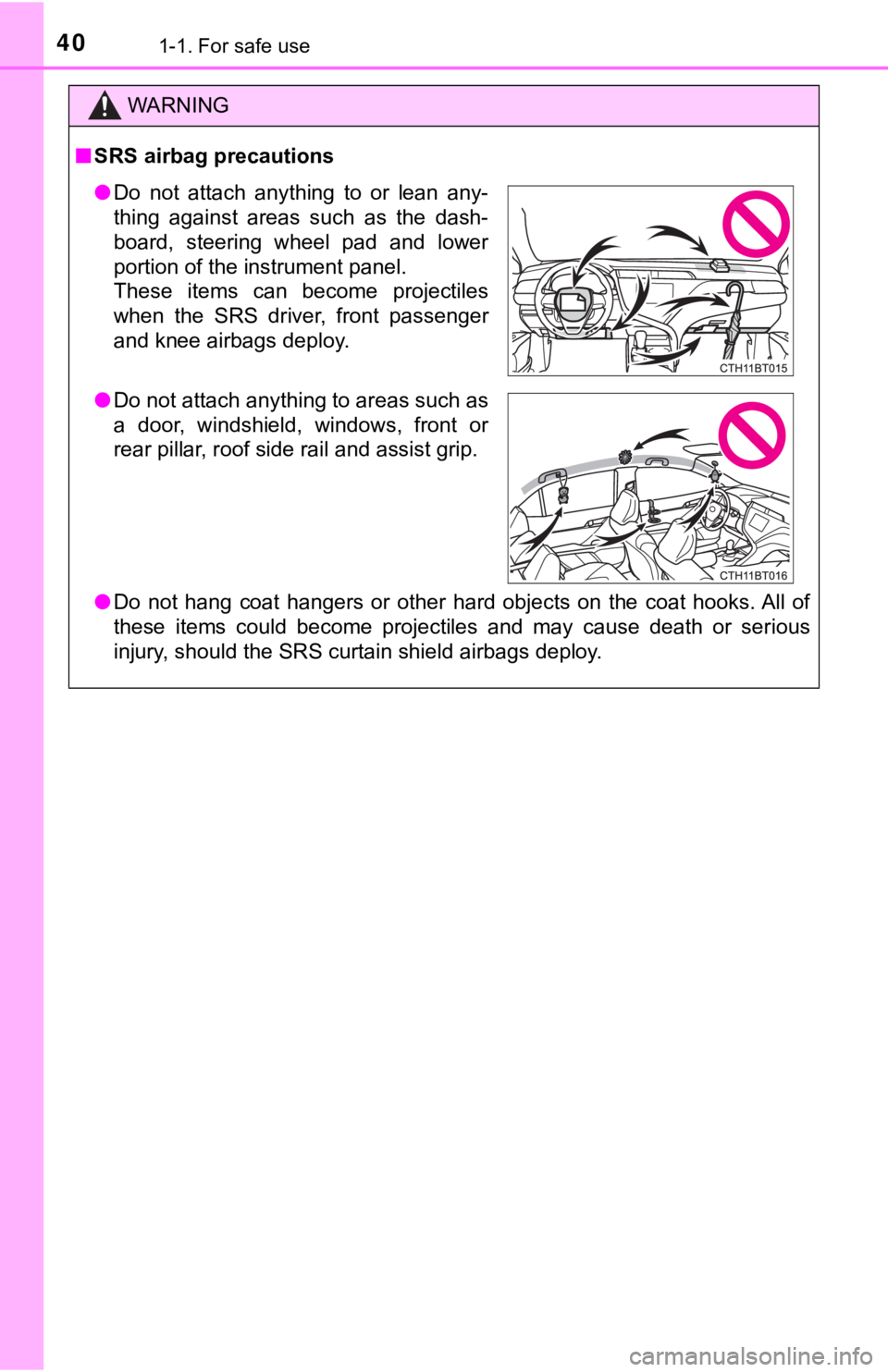steering TOYOTA CAMRY HYBRID 2019 Owners Manual (in English)
[x] Cancel search | Manufacturer: TOYOTA, Model Year: 2019, Model line: CAMRY HYBRID, Model: TOYOTA CAMRY HYBRID 2019Pages: 592, PDF Size: 10.78 MB
Page 2 of 592

TABLE OF CONTENTS2
For your information....................... 6
Reading this manual .................... 12
How to search .............................. 13
Pictorial index .............................. 14
1-1. For safe useBefore driving ...................... 24
For safe driving ................... 26
Seat belts ............................ 28
SRS airbags ........................ 34
Front passenger occupant classification
system............................... 47
Exhaust gas precautions ....................... 52
1-2. Child safety Riding with children ............. 53
Child restraint systems ........ 54
1-3. Emergency assistance Safety Connect.................... 73
1-4. Hybrid system Hybrid system features ....... 79
Hybrid system precautions ....................... 83
1-5. Theft deterrent system Immobilizer system ............. 90
Alarm ................................... 92 2. Instrument cluster
Warning lights and indicators ........................... 96
Gauges and meters ........... 102
Multi-information display (4.2-inch display) ............. 106
Multi-information display (7-inch display) ................ 118
Head-up display................. 134
Energy monitor/ consumption screen ........ 141
3-1. Key information Keys................................... 152
3-2. Opening, closing and locking the doors
Doors ................................. 156
Trunk ................................. 162
Smart key system .............. 166
3-3. Adjusting the seats Front seats......................... 175
Rear seats ......................... 177
Head restraints .................. 179
3-4. Adjusting the steering wheel and mirrors
Steering wheel ................... 181
Inside rear view mirror ....... 183
Outside rear view mirrors ............................. 185
3-5. Opening and closing the windows
Power windows.................. 187
Moon roof .......................... 190
1For safety and security
2Instrument cluster
3Operation of each
component
Page 3 of 592

3
1
9 7 6
5
4
3
2
8
4-1. Before drivingDriving the vehicle ............. 196
Cargo and luggage............ 204
Vehicle load limits ............. 207
Trailer towing..................... 208
Dinghy towing.................... 209
4-2. Driving procedures Power (ignition) switch ...... 210
EV drive mode................... 216
Hybrid transmission........... 219
Turn signal lever................ 225
Parking brake .................... 226
Brake Hold ........................ 230
4-3. Operating the lights and wipers
Headlight switch ................ 233
Automatic High Beam ....... 236
Windshield wipers and washer ............................ 240
4-4. Refueling Opening the fuel tank cap .................................. 244 4-5. Using the driving
support systems
Toyota Safety Sense P ...... 248
PCS (Pre-Collision System)..... 255
LDA (Lane Departure Alert
with steering control) ....... 266
Dynamic radar cruise control with full-speed
range ............................... 276
Driving assist systems ....... 290
BSM (Blind Spot Monitor)......... 297
• BSM function ................. 300
• RCTA function ............... 303
Rear Camera Detection Function........................... 307
Intuitive parking assist ....... 311
Intelligent Clearance Sonar (ICS) ..................... 319
Driving mode select switches........................... 340
4-6. Driving tips Hybrid vehicle driving tips ................................... 342
Winter driving tips .............. 345
4Driving
Page 17 of 592

17Pictorial index
Parking brake . . . . . . . . . . . . . . . . . . . . . . . . . . . . . . . . . . . . . P. 226
Applying/releasing . . . . . . . . . . . . . . . . . . . . . . . . . . . . . . P. 226, 227
Precautions for winter season . . . . . . . . . . . . . . . . . . . . . . . . . P. 346
Warning light/warning buzzer/
warning message . . . . . . . . . . . . . . . . . . . . . . . . . . . . . . . P. 229, 476
Turn signal lever . . . . . . . . . . . . . . . . . . . . . . . . . . . . . . . . . . P. 225
Headlight switch . . . . . . . . . . . . . . . . . . . . . . . . . . . . . . . . . . P. 233
Headlights/side marker lights/parking lights/tail lights/
license plate lights/daytime running lights . . . . . . . . . . . . . . . . P. 233
Windshield wiper and washer switch . . . . . . . . . . . . . . . . . P. 240
Usage . . . . . . . . . . . . . . . . . . . . . . . . . . . . . . . . . . . . . . . . . . . P. 240
Adding washer fluid . . . . . . . . . . . . . . . . . . . . . . . . . . . . . . . . . P. 419
Emergency flasher switch . . . . . . . . . . . . . . . . . . . . . . . . . . P. 470
Hood lock release lever. . . . . . . . . . . . . . . . . . . . . . . . . . . . . P. 410
Tilt and telescopic steering lock release lever . . . . . . . . . . P. 181
Air conditioning system . . . . . . . . . . . . . . . . . . . . . . . . . . . . P. 350
Usage . . . . . . . . . . . . . . . . . . . . . . . . . . . . . . . . . . . . . . . . . . . P. 350
Rear window defogger . . . . . . . . . . . . . . . . . . . . . . . . . . . . . . . P. 354
Entune Audio
*1, 2
Entune Audio Plus*1, 2
Entune Premium Audio*1, 2
Clock*2
4
5
6
7
8
9
10
11
*1: If equipped
*2: Refer to “NAVIGATION AND MULT IMEDIA SYSTEM OWNER’S MANUAL”.
Page 19 of 592

19Pictorial index
Meter control switches . . . . . . . . . . . . . . . . . . . . . . . . . P. 107, 119
Paddle shift switches
*1. . . . . . . . . . . . . . . . . . . . . . . . . . . . . P. 219
Vehicle-to-vehicle distance button . . . . . . . . . . . . . . . . . . . . P. 283
Cruise control switches
Dynamic radar cruise control with full-speed range . . . . . . . . . P. 276
Audio remote control switches
*2
LDA (Lane Departure Alert with steering control)
switch . . . . . . . . . . . . . . . . . . . . . . . . . . . . . . . . . . . . . . . . . . . P. 266
Phone switch
*2
Talk switch*2
1
2
3
4
5
6
7
8
*1: If equipped
*2: Refer to “NAVIGATION AND MULT IMEDIA SYSTEM OWNER’S MANUAL”.
Page 26 of 592

261-1. For safe use
Adjust the angle of the seat-
back so that you are sitting
straight up and so that you do
not have to lean forward to
steer. (P. 1 7 5 )
Adjust the seat so that you can
depress the pedals fully and so
that your arms bend slightly at
the elbow when gripping the
steering wheel. ( P. 175)
Lock the head restraint in place with the center of the head restraint
closest to the top of your ears. ( P. 1 7 9 )
Wear the seat belt correctly. ( P. 2 8 )
Make sure that all occupants are wearing their seat belts before driv-
ing the vehicle. ( P. 2 8 )
Use a child restraint system appropriate for the child until th e child
becomes large enough to properly wear the vehicle’s seat belt.
( P. 54)
For safe driving
For safe driving, adjust the seat and mirror to an appropriate
position before driving.
Correct driving posture
1
2
Correct use of the seat belts
3
4
Page 37 of 592

371-1. For safe use
1
For safety and security
WARNING
■SRS airbag precautions
Observe the following precautions regarding the SRS airbags.
Failure to do so may cause death or serious injury.
● The driver and all passengers in the vehicle must wear their se at belts
properly.
The SRS airbags are supplemental devices to be used with the se at belts.
● The SRS driver airbag deploys with considerable force, and can cause
death or serious injury especially if the driver is very close to the airbag.
The National Highway Traffic Safety Administration (NHTSA) advi ses:
Since the risk zone for the driver’s airbag is the first 2 - 3 in. (50 - 75 mm)
of inflation, placing yourself 10 in. (250 mm) from your driver airbag pro-
vides you with a clear margin of safety. This distance is measured from
the center of the steering wheel to your breastbone. If you sit less than 10
in. (250 mm) away now, you can change your driving position in several
ways:
• Move your seat to the rear as far as you can while still reach ing the ped-
als comfortably.
• Slightly recline the back of the seat. Although vehicle designs vary, many drivers can achieve the 10 in. (250
mm) distance, even with the driver seat all the way forward, si mply by
reclining the back of the seat somewhat. If reclining the back of your
seat makes it hard to see the road, raise yourself by using a f irm, non-
slippery cushion, or raise the seat if your vehicle has that feature.
• If your steering wheel is adjustable, tilt it downward. This points the air- bag toward your chest instead of your head and neck.
The seat should be adjusted as recommended by NHTSA above, whil e
still maintaining control of the foot pedals, steering wheel, and your view
of the instrument panel controls.
Page 40 of 592

401-1. For safe use
WARNING
■SRS airbag precautions
● Do not hang coat hangers or other hard objects on the coat hook s. All of
these items could become projectiles and may cause death or ser ious
injury, should the SRS curtain shield airbags deploy.
● Do not attach anything to or lean any-
thing against areas such as the dash-
board, steering wheel pad and lower
portion of the instrument panel.
These items can become projectiles
when the SRS driver, front passenger
and knee airbags deploy.
● Do not attach anything to areas such as
a door, windshield, windows, front or
rear pillar, roof side rail and assist grip.
Page 41 of 592

411-1. For safe use
1
For safety and security
WARNING
■SRS airbag precautions
● If a vinyl cover is put on the area where the SRS knee airbag w ill deploy,
be sure to remove it.
● Do not use seat accessories which cover the parts where the SRS side
airbags inflate as they may interfere with inflation of the air bags. Such
accessories may prevent the side airbags from activating correc tly, disable
the system or cause the side airbags to inflate accidentally, r esulting in
death or serious injury.
● Do not strike or apply significant levels of force to the area of the SRS air-
bag components or the front doors.
Doing so can cause the SRS airbags to malfunction.
● Do not touch any of the component parts immediately after the S RS air-
bags have deployed (inflated) as they may be hot.
● If breathing becomes difficult after the SRS airbags have deplo yed, open a
door or window to allow fresh air in, or leave the vehicle if i t is safe to do
so. Wash off any residue as soon as possible to prevent skin ir ritation.
● If the areas where the SRS airbags are stored, such as the steering wheel
pad and front and rear pillar garnishes, are damaged or cracked , have
them replaced by your Toyota dealer.
● Do not place anything, such as a cushion, on the front passenge r's seat.
Doing so will disperse the passenger's weight, which prevents t he sensor
from detecting the passenger's weight properly. As a result, th e SRS front
airbags for the front passenger may not deploy in the event of a collision.
Page 42 of 592

421-1. For safe use
WARNING
■Modification and disposal of SRS airbag system components
Do not dispose of your vehicle or perform any of the following modifications
without consulting your Toyota dealer. The SRS airbags may malfunction or
deploy (inflate) accidentally, causing death or serious injury.
● Installation, removal, disassembly and repair of the SRS airbag s
● Repairs, modifications, removal or replacement of the steering wheel,
instrument panel, dashboard, seats or seat upholstery, front, s ide and rear
pillars, roof side rails, front door panels, front door trims o r front door
speakers
● Modifications to the front door panel (such as making a hole in it)
● Repairs or modifications of the front fender, front bumper, or side of the
occupant compartment
● Installation of a grille guard (bull bars, kangaroo bar, etc.), snow plows,
winches, or roof luggage carrier
● Modifications to the vehicle’s suspension system
● Installation of electronic devices such as mobile two-way radio s and CD
players
● Modifications to your vehicle for a person with a physical disa bility
Page 43 of 592

431-1. For safe use
1
For safety and security
■If the SRS airbags deploy (inflate)
●Slight abrasions, burns, bruising etc., may be sustained from S RS airbags,
due to the extremely high speed deployment (inflation) by hot g ases.
● A loud noise and white powder will be emitted.
● Parts of the airbag module (steering wheel hub, airbag cover an d inflator) as
well as the front seats, parts of the front and rear pillars, and roof side rails,
may be hot for several minutes. The airbag itself may also be hot.
● The windshield may crack.
● For Safety Connect subscribers, if any of the following situations occur, the
system is designed to send an emergency call to the response center, noti-
fying them of the vehicle’s location (without needing to push t he “SOS” but-
ton) and an agent will attempt to speak with the occupants to a scertain the
level of emergency and assistance required. If the occupants are unable to
communicate, the agent automatically treats the call as an emer gency and
helps to dispatch the necessary emergency services. ( P. 73)
• An SRS airbag is deployed.
• A seat belt pretensioner is activated.
• The vehicle is involved in a severe rearend collision.
■ SRS airbag deployment condi tions (SRS front airbags)
● The SRS front airbags will deploy i n the event of an impact tha t exceeds the
set threshold level (the level of force corresponding to an app roximately 12 -
18 mph [20 - 30 km/h] frontal collision with a fixed wall that does not move or
deform).
However, this threshold velocity will be considerably higher in the following
situations:
• If the vehicle strikes an object, such as a parked vehicle or sign pole,
which can move or deform on impact
• If the vehicle is involved in an underride collision, such as a collision in
which the front of the vehicle “underrides”, or goes under, the bed of a
truck
● Depending on the type of collision, it is possible that only th e seat belt pre-
tensioners will activate.
● The SRS front airbags for the front passenger will not activate if there is no
passenger sitting in the front passenger seat. However, the SRS front air-
bags for the front passenger may deploy if luggage is put in the seat, even if
the seat is unoccupied.
■ SRS airbag deployment conditions (SRS side and curtain shield a irbags)
● The SRS side and curtain shield airbags will deploy in the even t of an
impact that exceeds the set threshold level (the level of force corresponding
to the impact force produced by an approximately 3300 lb. [1500 kg] vehicle
colliding with the vehicle cabin from a direction perpendicular to the vehicle
orientation at an approximate speed of 12 - 18 mph [20 - 30 km/ h]).